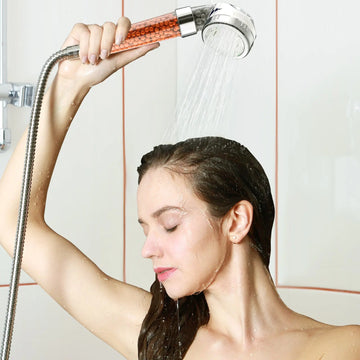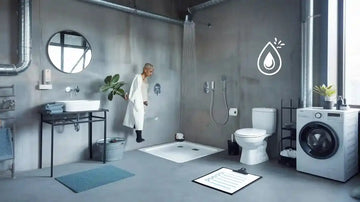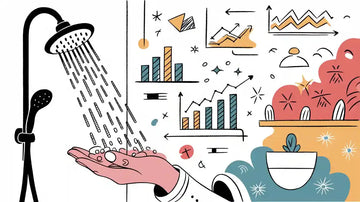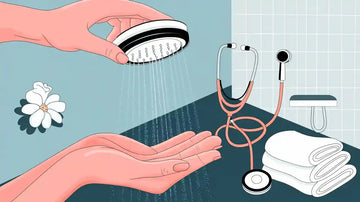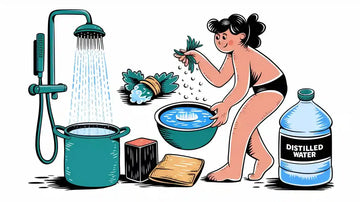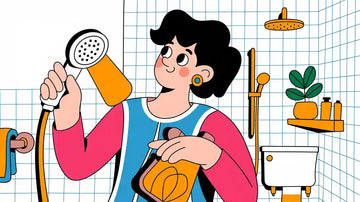You can save water in the shower in many ways. You do not have to use only water saving shower heads. Some people use timers or thermostatic valves. Others use pause controls or smart shower technology. Some pick recirculating systems. Others just change how they shower. Many people want other options. They may not like how low-flow shower heads feel. Some live in rentals. Others want better water quality. The chart below shows how much water each showerhead type uses. It helps explain why people want choices:
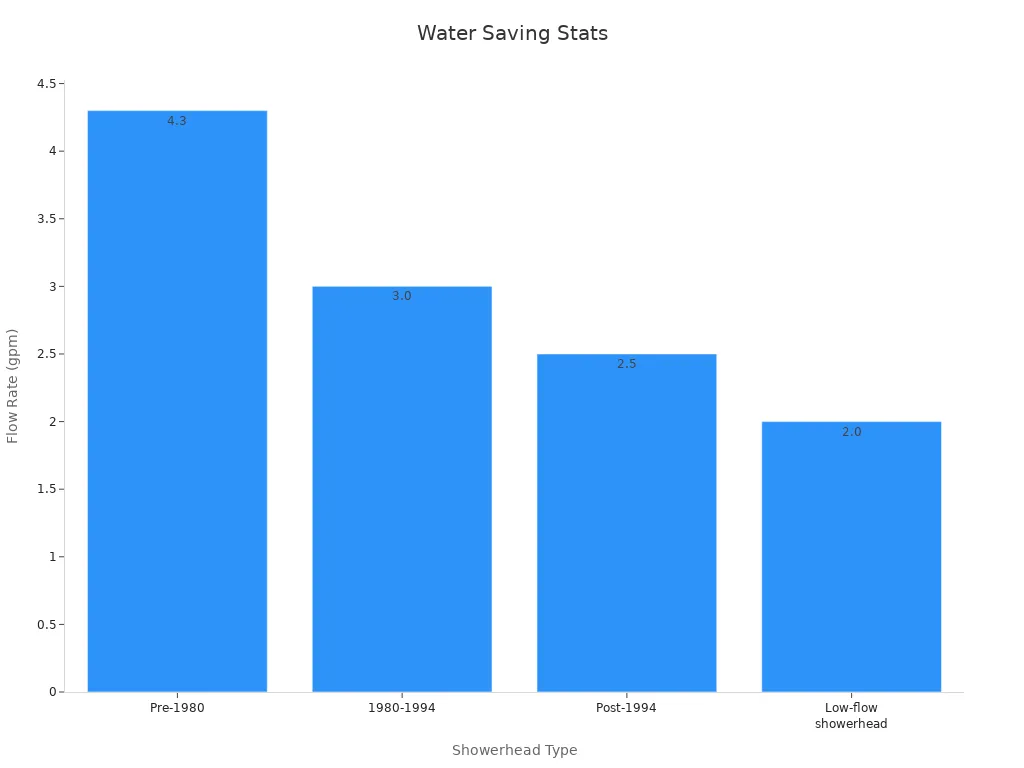
Premium filtered options like the Cobbe DS Filter Shower Head give you cleaner water. You can still save water with these options.
Key Takeaways
Shower timers or music playlists help you shower faster. You can save up to half your water this way. You do not need to change your routine much.
Thermostatic valves keep the water temperature steady. They help stop wasting water while waiting for it to warm up. These valves save water and energy. They also make showers safer.
Pause controls let you stop the water while you soap up. This helps you use less water. You do not lose comfort or the right temperature.
Recirculating shower systems clean and reuse water. They can save up to 90% of water and energy. But these systems cost a lot and need special setup.
Premium filtered shower heads make water cleaner. They also help save water. You get a healthy and comfortable shower with them.
Shower Timers
Shower timers help you keep track of how long you spend in the shower. You can use different types of timers to remind yourself when it is time to finish. Many people find that using a timer makes it easier to save water without changing their shower routine too much.
Manual Timers
Manual timers are simple tools. You set a timer before you start your shower. When the timer rings, you know it is time to get out. Some people use sand timers, kitchen timers, or waterproof clocks. These devices are easy to use and do not need batteries or electricity.
Studies show that using a timer can make a big difference. For example, a study reported by The Guardian in 2024 looked at 86,000 showers. It found that showers with high pressure and timers used about 17 liters of water on average. Showers without timers used almost 61 liters. This means you could save up to 53% of water by using a timer with normal water pressure.
However, manual timers work best when you pay attention to them. Research shows that manual timers mostly help you become more aware of your water use. They do not always lead to shorter showers or big drops in water bills. Devices like low-flow faucets or toilets often save more water because they limit the flow automatically.
Tip: Place your timer somewhere you can see or hear it while you shower. This helps you remember to finish on time.
Music Playlists
Music playlists offer a fun way to time your showers. You can pick a song or playlist that lasts as long as you want your shower to be. Many people use a two-minute song to keep their showers short.
The "2-Minute Shower Challenge" uses special songs to help you finish before the music ends.
Playing a two-minute song is an easy and flexible way to time yourself.
This method became popular in Cape Town, South Africa, during a drought.
Music makes timing your shower more enjoyable and helps you stick to your goal.
User feedback shows that music playlists help people stay within their target shower time and save water.
Try choosing your favorite upbeat song for your next shower. You might find it easier to finish quickly and have fun at the same time!
Thermostatic Valves
Thermostatic valves help you control the temperature of your shower water. These devices keep the water at a steady temperature, so you do not have to adjust the hot and cold taps over and over. You get the right temperature faster and waste less water.
Warm-Up Water Control
When you turn on a shower, you often wait for the water to reach the right temperature. Many people let water run down the drain during this time. Thermostatic valves solve this problem. They use special cartridges to keep the water at the exact temperature you set. You do not need to keep testing the water with your hand.
Jean-Jacques L’Henaff, a water technology expert, explains that thermostatic valves stop you from wasting water while you wait for it to warm up. Some digital thermostatic valves even shut off the water flow once it reaches your chosen temperature. This means you only use the water you need.
You also save energy. If you lower your shower temperature by just 1°C, you can save about 52 watt-hours of energy per shower. If a family takes 150 showers in a month, that adds up to about 7.8 kilowatt-hours saved. At a rate of 10¢ per kilowatt-hour, you save almost 80¢ each month. For homes that use off-grid power, this can mean big savings on equipment costs.
Tip: Thermostatic valves make your shower safer by preventing sudden changes in water temperature.
Installation Tips
You can get the most out of thermostatic valves by following a few key steps:
Choose a valve that meets safety standards like ASSE 1016 or ASME A112.18.1/CSA B125.1.
Make sure the valve fits your current plumbing and heating system.
Pick valves made from strong materials such as brass or stainless steel.
Look for safety features like quick shut-off to prevent burns.
Hire a professional for installation to avoid leaks or temperature problems.
Pair your valve with a low-flow showerhead that matches its flow rate.
Check and maintain your valve regularly to keep it working well.
By following these tips, you can enjoy a comfortable, safe, and water-saving shower every day.
Pause Controls
Pause controls give you a simple way to save water while you shower. You can stop the water flow when you do not need it, like when you lather up or shave. This method helps you use only the water you need.
Lathering Pause
You can use a pause button or lever on your showerhead to stop the water while you soap up. This feature is easy to use. You press the button, and the water stops. When you finish lathering, you press it again to start the water. You do not need to adjust the temperature each time. This keeps your shower comfortable and saves water at the same time.
Many people find this method helpful. You can take your time to wash your hair or body without wasting water. Some pause controls reduce the flow to a trickle instead of stopping it completely. This helps keep the water temperature steady. You do not get a sudden blast of cold or hot water when you restart the flow.
Tip: Try using the pause control every time you shampoo or shave. You may notice a big drop in your water use.
Flow Reducers
Flow reducers limit the amount of water that comes out of your showerhead. You install them between the shower arm and the showerhead. These small devices can make a big difference in your water use.
Here is a table that shows how flow reducers help you save water:
Evidence Aspect |
Details |
|---|---|
Water Savings Data |
A 1.5 gallons per minute flow regulator can save a family of four about 10,521 gallons per year. |
Historical Flow Rates |
Older showerheads used 5–8 gallons per minute; now the standard is 2.5 gallons per minute. |
Regulatory Changes |
California set strict rules: 2.5 gpm in 2016, then 1.8 gpm in 2018. |
Certification Importance |
WaterSense label means the product meets government standards. |
Practical Challenges |
Some people remove flow reducers, which can waste water and raise bills. |
User Experience Considerations |
Good design can keep showers comfortable even with lower flow. |
You should look for flow reducers with the WaterSense label. This label means the product meets strict standards for water savings. Some people worry about comfort, but many new designs spread water widely. This keeps your shower enjoyable while you save water.
Recirculating Shower Systems
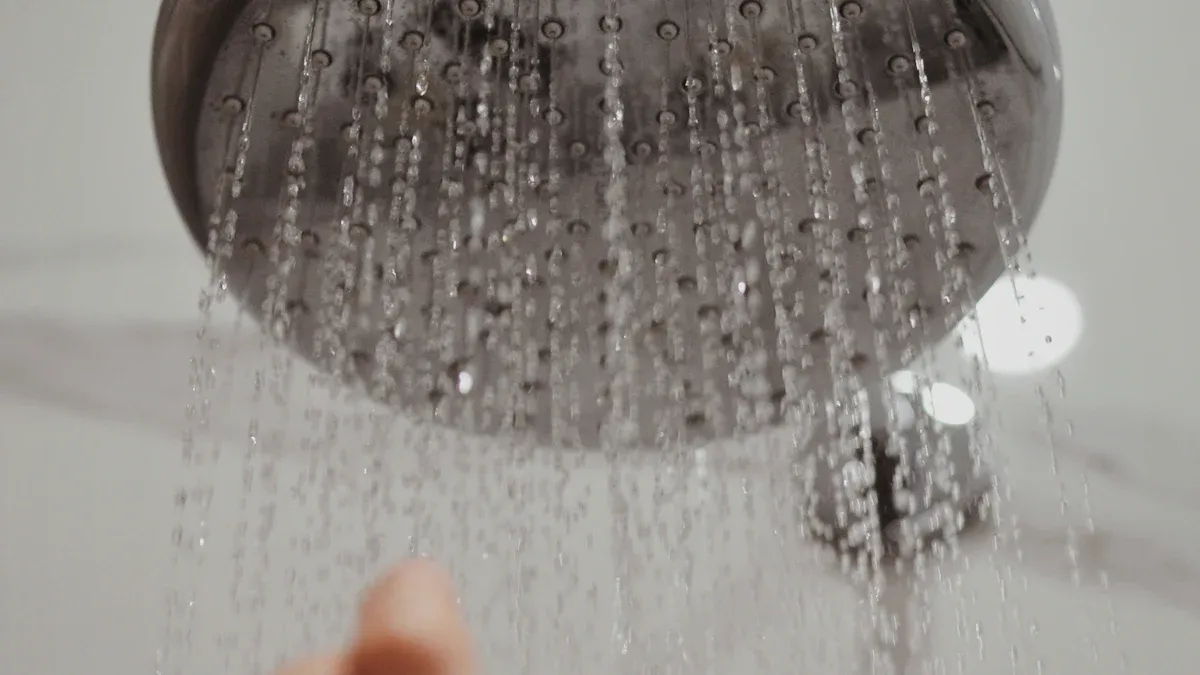
How They Work
Recirculating shower systems use smart technology to help you conserve water every time you shower. These systems collect the water that flows down the drain, clean it with filters, and send it back to your showerhead. You get a steady stream of warm water without wasting fresh water. The system heats the recycled water, so you do not need to wait for hot water to arrive. This process keeps your shower comfortable and helps you use less energy.
The system filters out dirt and soap, making sure the water stays clean and safe.
You can enjoy a long shower while using much less water than a regular shower.
Some systems use sensors to check water quality and temperature, giving you peace of mind.
Heating water takes a lot of energy in most homes. By recycling warm water, you cut down on energy use. You also help the environment by reducing the amount of water you need from your local supply.
Note: Current rules say that shower water must meet drinking water standards. This limits how many people can use these systems, but new rules may change this in the future.
Water Savings
You can make a big difference in your water usage with a recirculating shower system. These systems can reduce water consumption by up to 90%. That means you use only a small part of the water you would with a regular shower.
Hot water recirculation can save about 30 gallons of water per person each day.
Over a month, this adds up to nearly 300 gallons saved for each person.
In one year, a typical home can save more than 3,500 gallons of water.
Most homes waste over 11,000 gallons each year just waiting for hot water. Recirculating systems help you conserve water by stopping this waste.
Each shower can save 1 to 3 gallons of water, which helps the planet and lowers your bills.
You also save energy because you do not need to heat new water for every shower. This helps you reach net-zero energy goals and supports a more sustainable lifestyle.
Smart Shower Technology
Smart shower technology helps you save water and energy in new ways. These tools use sensors, digital screens, and apps to help you watch your shower habits. You can see feedback right away, set goals, and even link your shower to your phone. This technology makes saving water easier without losing comfort.
Digital Timers
Digital timers show you how long you are in the shower. Some timers show the time on the shower wall. Others use lights or sounds to tell you when to stop. You can set your own time limit and get alerts if you go over.
Studies show digital timers with live feedback help people take shorter showers. In hotels in Europe, guests who saw water use data and messages used about 20% less water than others. Digital timers often have eco-modes that lower flow to 1.8 gallons per minute. This can save up to 40% more water than normal showers.
Feature |
Digital Shower Timers/Controls |
Traditional Shower Timers/Controls |
Water/Energy Impact |
|---|---|---|---|
Water Consumption Reduction |
Up to 30% reduction via eco-settings |
Typically 15-25% more water consumption |
Digital saves significantly more water |
Flow Rate |
Eco-modes limit flow to 1.8 gallons per minute |
Standard flow rate around 2.5 gallons per minute |
Up to 40% water savings with digital |
Temperature Control |
Precise electronic sensors, no manual adjustment |
Manual adjustments cause temperature fluctuations |
Reduces water waste waiting for temperature |
Energy Efficiency |
20-25% greater efficiency via optimized heating |
Wastes energy during 30-45 seconds warm-up |
Digital reduces energy and water waste |
Additional Features |
Automatic shut-off, real-time usage tracking, programmable presets, smart home integration |
Manual operation, no real-time feedback |
Enhances water conservation and user control |
Tip: Try using a digital timer to set a shower goal. You can see your progress and feel good about saving water.
App Integration
Many smart showers work with apps on your phone or tablet. You can track water use, set reminders, and change shower settings from anywhere. Some apps let each family member have their own profile. This helps everyone in your house save water.
You can check your water and energy use over time.
Some apps send alerts if you use too much water.
You can set up automatic shut-off for extra savings.
Smart shower apps help you build better habits. You get feedback and control right away, so you use less water every day.
Fixture Upgrades
Low-Flow Shower Head Alternatives
You have lots of ways to save water in the shower. You do not need to use only water saving shower heads. Low-flow shower head models help you use less water but still feel comfortable. Most regular showerheads use about 2.5 gallons each minute. A low-flow shower head with the WaterSense label uses 2.0 gallons or less per minute. This switch can save your family about 2,700 gallons of water every year. You also save more than 330 kilowatt-hours of electricity because you heat less water.
Here is a table that shows how much water different shower heads use and how much they save:
Shower Head Type/Model |
Flow Rate (GPM) |
Annual Water Savings (gallons) |
Additional Notes |
|---|---|---|---|
Conventional (pre-1992) |
5.5+ |
N/A |
Typical flow before regulation |
Energy Policy Act (1992) limit |
2.5 max |
N/A |
Federal maximum flow rate |
Some states (CA, NY, CO) limit |
2.0 max |
N/A |
Stricter state regulations |
Niagara Earth Massage |
1.25 |
N/A |
Low flow, budget-friendly |
Aqua Elegante |
1.8 |
N/A |
Water-saving technology |
ShowerStart Evolve |
1.5 |
~2000+ |
Saves ~8 gallons per 5-minute shower warm-up |
Waterpick XRO-763 |
2.5 |
N/A |
Higher flow low-flow option |
EPA WaterSense labeled showerheads |
≤2.0 |
~2700 |
At least 20% water savings vs conventional models |
You can see that using a low-flow shower head saves a lot of water. Some models, like the Niagara Earth Massage, use only 1.25 gallons per minute. If you want to save water but do not like how some water saving shower heads feel, try a low-flow shower head with different spray settings. Many people think these are more comfortable than old water saving shower heads.
Faucet Aerators
Faucet aerators help you use less water at the sink. You screw them onto the end of your faucet. They mix air with the water. This lowers the flow but keeps the pressure strong. You use less water when you wash your hands or brush your teeth.
Flow rate is important. Aerators can lower the flow to just 1.0 gallon per minute.
How much water you save depends on how long and how often you use the faucet.
Studies show faucet aerators can cut water use by about 13% in a normal home.
Your habits matter. If you leave the water running, you might not save as much.
Aerators work best when you use them with other water-saving habits.
You can use faucet aerators with a low-flow shower head to save even more water. Many people find these upgrades easy to put in and not expensive. If you want to pay less for water and help the planet, try adding aerators to your sinks and use a water saving shower head too.
Cold Showers
Shorter Showers
You can save a lot of water by taking shorter showers, especially if you use cold water. Most people spend about eight minutes in the shower. A standard showerhead uses around 2.1 gallons of water each minute. That means you use almost 25 gallons for one shower. If you cut your shower time to five minutes, you could save about 45 gallons every week. This small change adds up over time.
Michigan State University ran a Shorter Shower Initiative. Students used timers and reminders to help them take shorter showers. The program found that even small reductions in shower time made a big difference. Less time in the shower means less heated water, which also lowers energy use and carbon emissions. The United Nations Foundation says that if you limit your showers to five minutes, you could reduce carbon emissions as much as half an acre of U.S. forest can absorb in a year. The EPA also notes that using water-efficient showerheads and taking shorter showers could save billions of gallons of water and billions of dollars every year.
Tip: Try setting a timer or playing a short song to help you finish your cold shower quickly.
Health Benefits
Cold showers do more than just save water. They can also help your body and mind in several ways:
Improved circulation and less muscle soreness: Cold water makes your blood vessels tighten, then relax, which helps move oxygen and remove waste from your muscles. Athletes often use cold water to recover faster after exercise.
Better skin and hair: Cold water keeps your skin’s natural oils and helps your hair look shiny. It can also make your skin feel less puffy.
Boosted mood: Cold showers can trigger endorphins, which help lower stress and anxiety. Some studies show that cold showers may even reduce feelings of depression.
Stronger immune system: Cold water can help your body produce more white blood cells, which fight off illness.
Possible metabolism boost: Cold showers may help your body burn more energy as it works to stay warm.
If you want to save water and feel healthier, try making cold showers a regular part of your routine.
Beyond Water-Saving Shower Head
You may want more from your shower than just saving water. Premium filtered shower heads, like the Cobbe DS Filter Shower Head, give you a new way to improve your shower experience. These shower heads do more than a typical low-flow shower head. They help you conserve water and also protect your health.
The Cobbe DS Filter Shower Head uses a 20-stage filtration system. This system removes over 99% of chlorine and heavy metals, such as lead and mercury. You get cleaner water every time you shower. Cleaner water can make your skin feel softer and your hair look shinier. Many people notice less dryness and irritation after switching to a filtered shower head.
You can choose from five spray modes. These include rain, massage, mist, water-saving, and power wash. Each mode lets you control how the water feels. The built-in flow restrictor works like a low-flow shower head. It helps you use less water without losing water pressure. You still get a strong, steady stream.
Filtered shower heads like Cobbe’s model fit most standard showers. You can install one in minutes without tools. The filter lasts for months, so you do not need to change it often. You also get a stylish look with color choices like Chrome, Matte Black, and Ocean Blue.
If you want to conserve water and care about water quality, a premium filtered shower head is a smart choice. You get the benefits of a low-flow shower head and extra protection for your skin and hair. You do not have to settle for just water saving shower heads. You can enjoy a better shower and help the planet at the same time.
Note: Filtered shower heads can address worries about chlorine, heavy metals, and skin or hair health. You still save water with every shower.
Comparison Table
Pros and Cons
There are many ways to save water in the shower. Each way has good points and bad points. The table below shows how each method is different. You can use this to help you choose what works for you.
Method |
Pros |
Cons |
|---|---|---|
Shower Timers |
Simple to use, not expensive, helps you notice water use |
You need to pay attention, may not save water if ignored |
Thermostatic Valves |
Saves water and energy, keeps water the same temperature |
Costs more at first, might need a plumber to install |
Pause Controls |
Easy to use, saves water when you soap up |
Might not stop all water, not on every showerhead |
Recirculating Systems |
Can save almost all water, keeps water warm |
Very costly, hard to install, not allowed everywhere |
Smart Shower Technology |
Shows your use, gives tips, lets you set goals |
Needs Wi-Fi and power, costs more |
Fixture Upgrades (Aerators, Low-Flow) |
Saves water by itself, easy to put in |
Some people do not like less water pressure |
Cold Showers |
Uses less water and energy, good for health |
Feels cold for some, not everyone likes it |
Premium Filtered Shower Heads |
Makes water cleaner, saves water, easy to put in |
Filter must be changed, costs more than basic shower heads |
Experts use a few steps to check these methods:
They look at water use in many homes.
They remind people to save water.
They use smart meters to watch water use over time.
They compare people who try new ways with those who do not.
They think about things like home size and how much water people used before.
They check again later to see if people keep saving water.
Best Fit for Your Needs
Picking the best way to save water depends on your home and habits. The table below shows what to try based on your needs.
What It Means for You |
Best Water-Saving Methods to Try |
|
|---|---|---|
Household Size |
More people means more water used |
Smart tech, recirculating systems, timers |
Home Type |
Renters need easy ways that do not need tools |
Timers, pause controls, filtered shower heads |
Water Habits |
If you already take quick showers |
Aerators, thermostatic valves, filtered heads |
Water Quality Concerns |
If you have sensitive skin or hard water |
Premium filtered shower heads |
Budget |
If you want to spend less money |
Timers, aerators, pause controls |
Tech Comfort |
If you like using apps or smart devices |
Smart shower technology, digital timers |
Local Rules |
If you live where water is limited or rules are strict |
Recirculating systems, low-flow heads, thermostatic valves |
You can pick the best way to save water for you. If you want clean water and easy setup, try a premium filtered shower head. If you want to see your progress, smart tech can help. Your home, habits, and goals all matter when you choose how to save water.
There are lots of ways to save water in the shower. You can use timers, thermostatic valves, or pause controls. Recirculating systems and premium filtered shower heads also help. The Cobbe DS Filter Shower Head is one example. These tools help you use less water and still enjoy your shower. Studies show your habits matter a lot. The technology you pick also makes a big difference. Even small changes can help you use less water. You might also feel healthier with these changes.
FAQ
How much water can you save by using a shower timer?
You can save up to 53% of water by using a shower timer. Timers help you finish faster. You become more aware of your water use. Many people find this method easy and effective.
Do filtered shower heads like the Cobbe DS Filter Shower Head reduce water pressure?
No, filtered shower heads like the Cobbe DS Filter Shower Head keep strong water pressure. The built-in flow restrictor helps save water. You still enjoy a powerful and comfortable shower.
Can you install a premium filtered shower head in a rental apartment?
Yes, you can install most premium filtered shower heads in a rental. They fit standard shower arms. You do not need tools. You can remove them easily when you move out.
What is the best way to save water if you have a large family?
Try using smart shower technology, timers, or recirculating systems. These methods help everyone use less water. You can track usage and set goals for your family.
Are cold showers better for your skin and hair?
Yes, cold showers help keep your skin’s natural oils. Your hair looks shinier and feels softer. Cold water can also reduce puffiness and help you feel refreshed.
